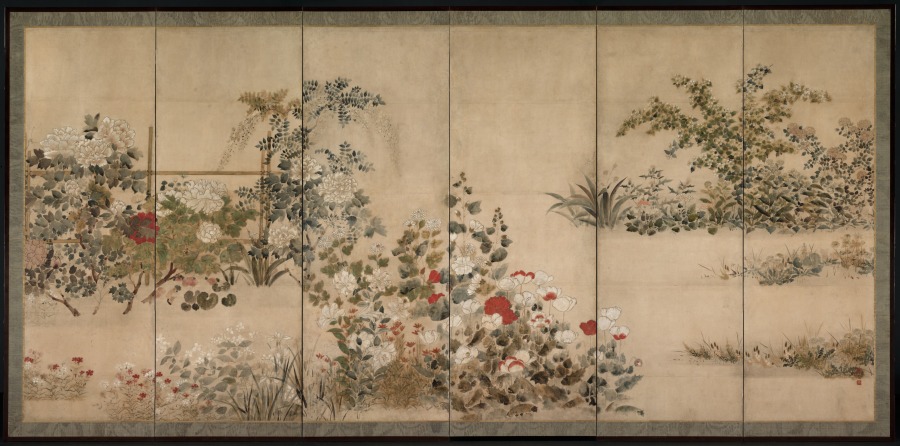| schema:description | "wall_description: Ascertaining the identity of the painter known as Kitagawa Sōsetsu from the first half of the seventeenth century remains an elusive but fascinating task. Unlike his more versatile predecessor Tawaraya Sōtatsu (died c. 1640), Sōsetsu painted only byōbu and hanging scroll compositions. While he did not collaborate with Kyoto's well-known calligraphers, book designers, or literary or court figures, attractive images such as appear on these byōbu were popular at the time, judging from the number of pieces that survive. In this respect, while his career is shadowy, it is much like those of the many well-regarded salon painters of the seventeenth and eighteenth centuries in Paris whose fame and identity have moved into and out of focus over the centuries. <br><br>Basically, the historical personage of Sōsetsu can be assessed in two ways. One view, his assumption at Sōsetsu's death to the position of master painter with the honorary Buddhist title Hōkkyō (Bridge of the Law), follows the normal course of events for promotion and the continued well-being of the master's studio. The other approach regards his paintings as aesthetically distinctive in their own right, giving credit to the clients and patrons of the Takagamine artists' colony founded by Sōsetsu and Hon'ami Kōetsu (1558-1637) as insightfully realizing a new generation of creativity and promoting its recognition. Whatever the theory, the most compelling documents for consideration are simply the many delightful paintings of annual flora that have tradition-ally been ascribed to Sōsetsu. Single hanging scroll compositions as well as sets predominate, although they tend to be in poor condition precisely because they were so well used as interior design elements. Many, moreover, have questionable seal impressions or no identifying seals at all. In a collaborative studio operation as successful as that of his predecessor Sōsetsu, the master's hand seldom emerges unequivocally, and Sōsetsu's assumption of that supervisory role is perhaps best considered by viewing the large intact floral compositions without weighty regard given to any seals present (in this instance a rounded Sōsetsu "Inen" seal, and square red "Sōsetsu" impression). <br><br>These byōbu are remarkable for their lack of ostensible décor. An airy composition and subtly controlled pools of wet ink describing variegated leaf forms characterize the pictorial attitude. Eschewing a gold-foil background, the artist composed islands of vegetation, which upon close inspection reveal an orchestrated succession of brushstrokes and carefully adjusted ink washes whose shapes identify a bewildering array of flowers categorized according to the passage of the seasons (beginning with spring on the right). No outlining brush-strokes define shapes. The only indications of ground are pale ink washes at the base of a floral group, and man's presence is denoted by a simple, plain wooden trellis supporting the wood peonies and young wisteria. <br><br>Unlike the seventeenth-century floral still-life painting tradition in Europe, this view of plant life has many perspectives, professes little interest in portraying objective reality or presenting overt painterly skills, and lacks any dazzling worldly goods to enhance its appearance. Comparison with <em>Autumn Evening with Full Moon on Musashino Plain</em> [2000.4.1-2] is instructive, revealing in its quiet artificiality an early, innovative Rinpa (school of Kōrin) approach to composition while suggesting age-old references to idealized garden of paradise settings in religious paintings. Ogata Kōrin (1658-1716) and his followers represent a further stage in the evolution of such imagery and references....(more)" |

